2006 MERCEDES-BENZ SPRINTER air condition
[x] Cancel search: air conditionPage 2117 of 2305
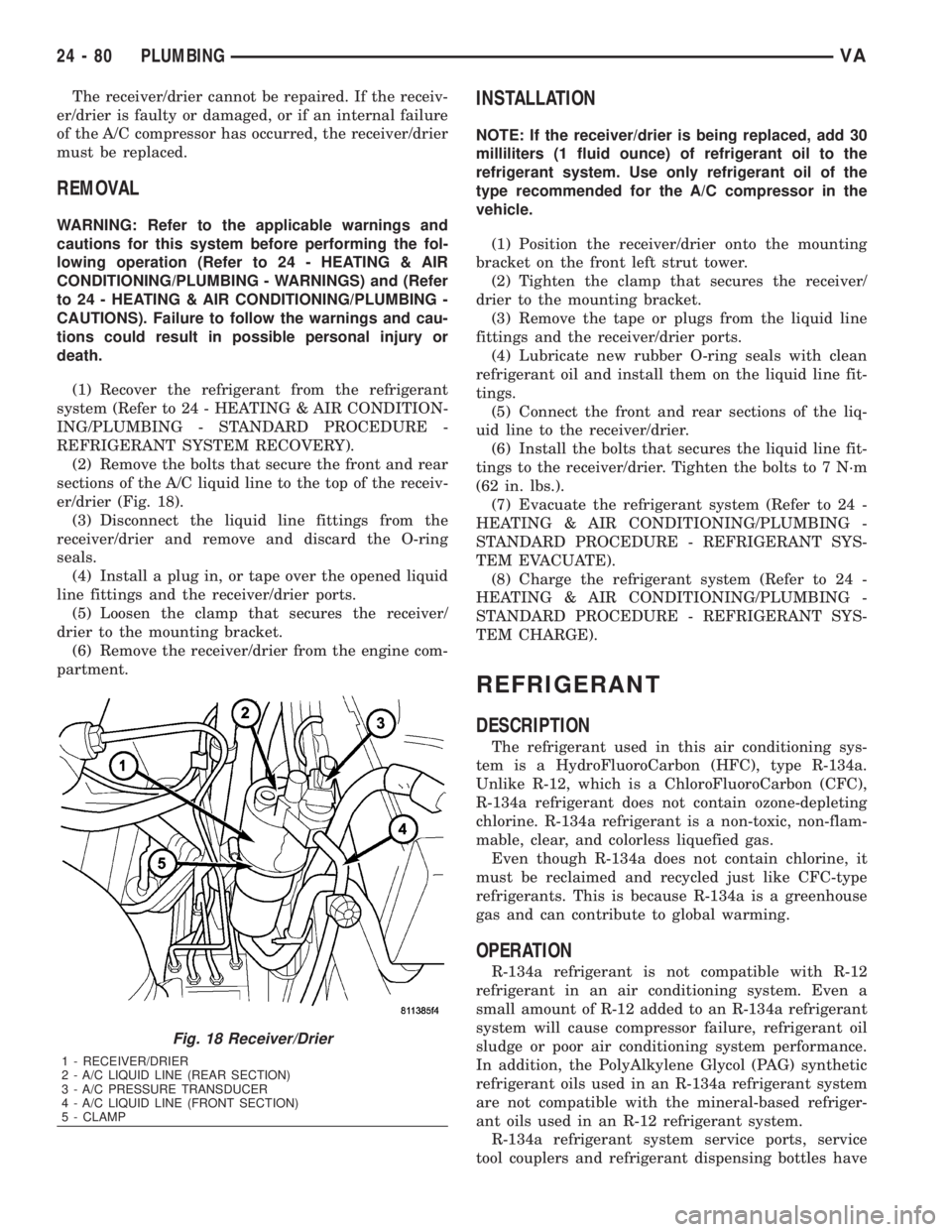
The receiver/drier cannot be repaired. If the receiv-
er/drier is faulty or damaged, or if an internal failure
of the A/C compressor has occurred, the receiver/drier
must be replaced.
REMOVAL
WARNING: Refer to the applicable warnings and
cautions for this system before performing the fol-
lowing operation (Refer to 24 - HEATING & AIR
CONDITIONING/PLUMBING - WARNINGS) and (Refer
to 24 - HEATING & AIR CONDITIONING/PLUMBING -
CAUTIONS). Failure to follow the warnings and cau-
tions could result in possible personal injury or
death.
(1) Recover the refrigerant from the refrigerant
system (Refer to 24 - HEATING & AIR CONDITION-
ING/PLUMBING - STANDARD PROCEDURE -
REFRIGERANT SYSTEM RECOVERY).
(2) Remove the bolts that secure the front and rear
sections of the A/C liquid line to the top of the receiv-
er/drier (Fig. 18).
(3) Disconnect the liquid line fittings from the
receiver/drier and remove and discard the O-ring
seals.
(4) Install a plug in, or tape over the opened liquid
line fittings and the receiver/drier ports.
(5) Loosen the clamp that secures the receiver/
drier to the mounting bracket.
(6) Remove the receiver/drier from the engine com-
partment.
INSTALLATION
NOTE: If the receiver/drier is being replaced, add 30
milliliters (1 fluid ounce) of refrigerant oil to the
refrigerant system. Use only refrigerant oil of the
type recommended for the A/C compressor in the
vehicle.
(1) Position the receiver/drier onto the mounting
bracket on the front left strut tower.
(2) Tighten the clamp that secures the receiver/
drier to the mounting bracket.
(3) Remove the tape or plugs from the liquid line
fittings and the receiver/drier ports.
(4) Lubricate new rubber O-ring seals with clean
refrigerant oil and install them on the liquid line fit-
tings.
(5) Connect the front and rear sections of the liq-
uid line to the receiver/drier.
(6) Install the bolts that secures the liquid line fit-
tings to the receiver/drier. Tighten the bolts to 7 N´m
(62 in. lbs.).
(7) Evacuate the refrigerant system (Refer to 24 -
HEATING & AIR CONDITIONING/PLUMBING -
STANDARD PROCEDURE - REFRIGERANT SYS-
TEM EVACUATE).
(8) Charge the refrigerant system (Refer to 24 -
HEATING & AIR CONDITIONING/PLUMBING -
STANDARD PROCEDURE - REFRIGERANT SYS-
TEM CHARGE).
REFRIGERANT
DESCRIPTION
The refrigerant used in this air conditioning sys-
tem is a HydroFluoroCarbon (HFC), type R-134a.
Unlike R-12, which is a ChloroFluoroCarbon (CFC),
R-134a refrigerant does not contain ozone-depleting
chlorine. R-134a refrigerant is a non-toxic, non-flam-
mable, clear, and colorless liquefied gas.
Even though R-134a does not contain chlorine, it
must be reclaimed and recycled just like CFC-type
refrigerants. This is because R-134a is a greenhouse
gas and can contribute to global warming.
OPERATION
R-134a refrigerant is not compatible with R-12
refrigerant in an air conditioning system. Even a
small amount of R-12 added to an R-134a refrigerant
system will cause compressor failure, refrigerant oil
sludge or poor air conditioning system performance.
In addition, the PolyAlkylene Glycol (PAG) synthetic
refrigerant oils used in an R-134a refrigerant system
are not compatible with the mineral-based refriger-
ant oils used in an R-12 refrigerant system.
R-134a refrigerant system service ports, service
tool couplers and refrigerant dispensing bottles have
Fig. 18 Receiver/Drier
1 - RECEIVER/DRIER
2 - A/C LIQUID LINE (REAR SECTION)
3 - A/C PRESSURE TRANSDUCER
4 - A/C LIQUID LINE (FRONT SECTION)
5 - CLAMP
24 - 80 PLUMBINGVA
Page 2118 of 2305
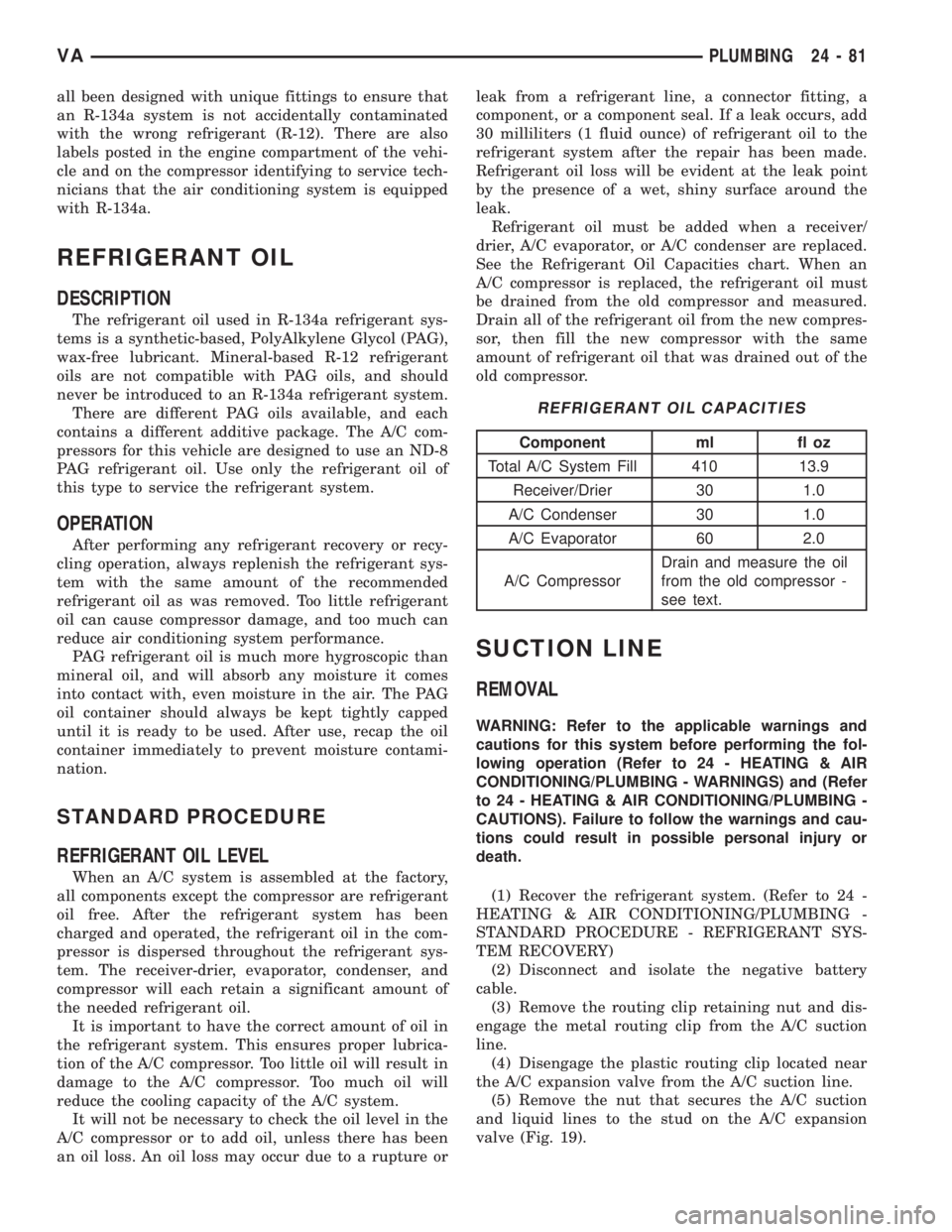
all been designed with unique fittings to ensure that
an R-134a system is not accidentally contaminated
with the wrong refrigerant (R-12). There are also
labels posted in the engine compartment of the vehi-
cle and on the compressor identifying to service tech-
nicians that the air conditioning system is equipped
with R-134a.
REFRIGERANT OIL
DESCRIPTION
The refrigerant oil used in R-134a refrigerant sys-
tems is a synthetic-based, PolyAlkylene Glycol (PAG),
wax-free lubricant. Mineral-based R-12 refrigerant
oils are not compatible with PAG oils, and should
never be introduced to an R-134a refrigerant system.
There are different PAG oils available, and each
contains a different additive package. The A/C com-
pressors for this vehicle are designed to use an ND-8
PAG refrigerant oil. Use only the refrigerant oil of
this type to service the refrigerant system.
OPERATION
After performing any refrigerant recovery or recy-
cling operation, always replenish the refrigerant sys-
tem with the same amount of the recommended
refrigerant oil as was removed. Too little refrigerant
oil can cause compressor damage, and too much can
reduce air conditioning system performance.
PAG refrigerant oil is much more hygroscopic than
mineral oil, and will absorb any moisture it comes
into contact with, even moisture in the air. The PAG
oil container should always be kept tightly capped
until it is ready to be used. After use, recap the oil
container immediately to prevent moisture contami-
nation.
STANDARD PROCEDURE
REFRIGERANT OIL LEVEL
When an A/C system is assembled at the factory,
all components except the compressor are refrigerant
oil free. After the refrigerant system has been
charged and operated, the refrigerant oil in the com-
pressor is dispersed throughout the refrigerant sys-
tem. The receiver-drier, evaporator, condenser, and
compressor will each retain a significant amount of
the needed refrigerant oil.
It is important to have the correct amount of oil in
the refrigerant system. This ensures proper lubrica-
tion of the A/C compressor. Too little oil will result in
damage to the A/C compressor. Too much oil will
reduce the cooling capacity of the A/C system.
It will not be necessary to check the oil level in the
A/C compressor or to add oil, unless there has been
an oil loss. An oil loss may occur due to a rupture orleak from a refrigerant line, a connector fitting, a
component, or a component seal. If a leak occurs, add
30 milliliters (1 fluid ounce) of refrigerant oil to the
refrigerant system after the repair has been made.
Refrigerant oil loss will be evident at the leak point
by the presence of a wet, shiny surface around the
leak.
Refrigerant oil must be added when a receiver/
drier, A/C evaporator, or A/C condenser are replaced.
See the Refrigerant Oil Capacities chart. When an
A/C compressor is replaced, the refrigerant oil must
be drained from the old compressor and measured.
Drain all of the refrigerant oil from the new compres-
sor, then fill the new compressor with the same
amount of refrigerant oil that was drained out of the
old compressor.
REFRIGERANT OIL CAPACITIES
Component ml fl oz
Total A/C System Fill 410 13.9
Receiver/Drier 30 1.0
A/C Condenser 30 1.0
A/C Evaporator 60 2.0
A/C CompressorDrain and measure the oil
from the old compressor -
see text.
SUCTION LINE
REMOVAL
WARNING: Refer to the applicable warnings and
cautions for this system before performing the fol-
lowing operation (Refer to 24 - HEATING & AIR
CONDITIONING/PLUMBING - WARNINGS) and (Refer
to 24 - HEATING & AIR CONDITIONING/PLUMBING -
CAUTIONS). Failure to follow the warnings and cau-
tions could result in possible personal injury or
death.
(1) Recover the refrigerant system. (Refer to 24 -
HEATING & AIR CONDITIONING/PLUMBING -
STANDARD PROCEDURE - REFRIGERANT SYS-
TEM RECOVERY)
(2) Disconnect and isolate the negative battery
cable.
(3) Remove the routing clip retaining nut and dis-
engage the metal routing clip from the A/C suction
line.
(4) Disengage the plastic routing clip located near
the A/C expansion valve from the A/C suction line.
(5) Remove the nut that secures the A/C suction
and liquid lines to the stud on the A/C expansion
valve (Fig. 19).
VAPLUMBING 24 - 81
Page 2120 of 2305
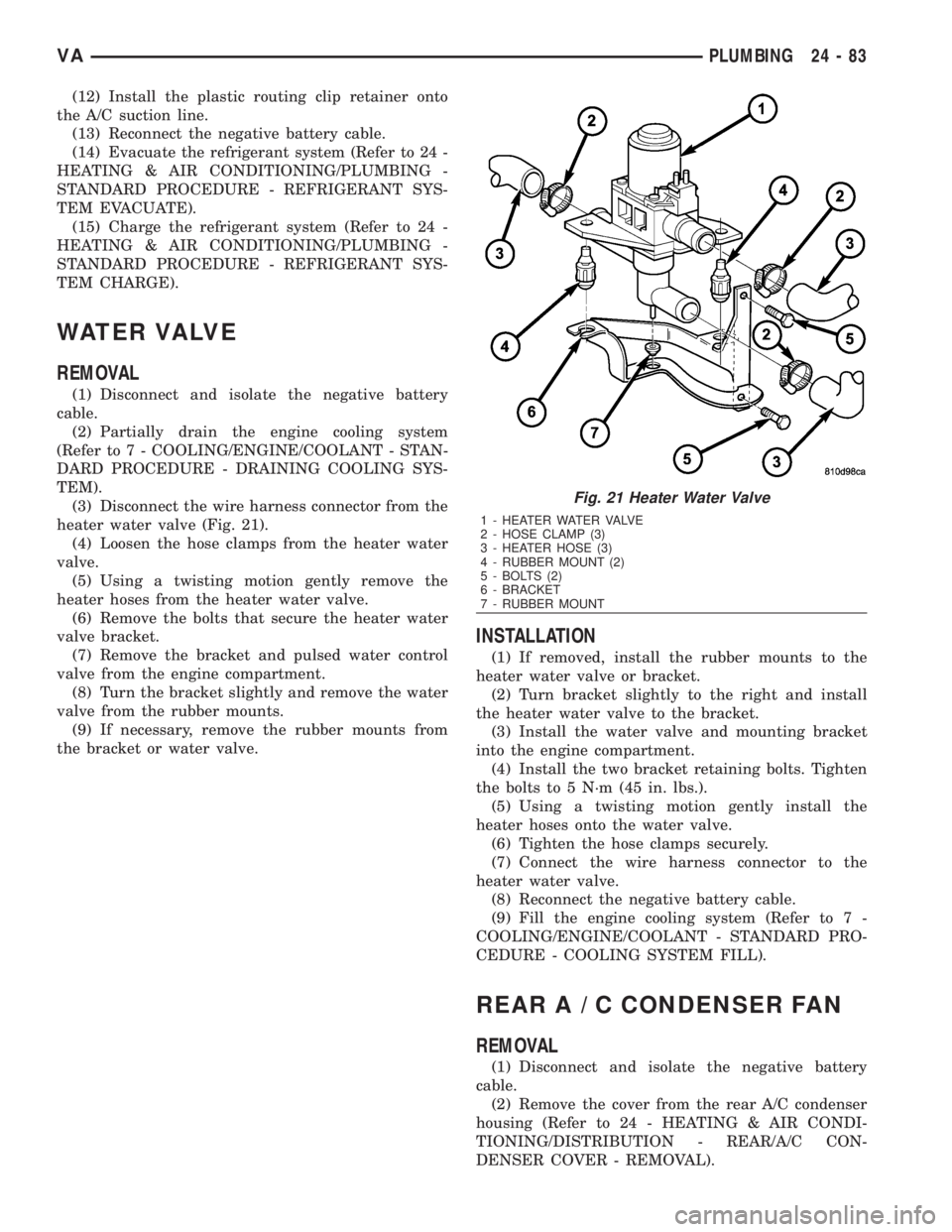
(12) Install the plastic routing clip retainer onto
the A/C suction line.
(13) Reconnect the negative battery cable.
(14) Evacuate the refrigerant system (Refer to 24 -
HEATING & AIR CONDITIONING/PLUMBING -
STANDARD PROCEDURE - REFRIGERANT SYS-
TEM EVACUATE).
(15) Charge the refrigerant system (Refer to 24 -
HEATING & AIR CONDITIONING/PLUMBING -
STANDARD PROCEDURE - REFRIGERANT SYS-
TEM CHARGE).
WATER VALVE
REMOVAL
(1) Disconnect and isolate the negative battery
cable.
(2) Partially drain the engine cooling system
(Refer to 7 - COOLING/ENGINE/COOLANT - STAN-
DARD PROCEDURE - DRAINING COOLING SYS-
TEM).
(3) Disconnect the wire harness connector from the
heater water valve (Fig. 21).
(4) Loosen the hose clamps from the heater water
valve.
(5) Using a twisting motion gently remove the
heater hoses from the heater water valve.
(6) Remove the bolts that secure the heater water
valve bracket.
(7) Remove the bracket and pulsed water control
valve from the engine compartment.
(8) Turn the bracket slightly and remove the water
valve from the rubber mounts.
(9) If necessary, remove the rubber mounts from
the bracket or water valve.
INSTALLATION
(1) If removed, install the rubber mounts to the
heater water valve or bracket.
(2) Turn bracket slightly to the right and install
the heater water valve to the bracket.
(3) Install the water valve and mounting bracket
into the engine compartment.
(4) Install the two bracket retaining bolts. Tighten
the bolts to 5 N´m (45 in. lbs.).
(5) Using a twisting motion gently install the
heater hoses onto the water valve.
(6) Tighten the hose clamps securely.
(7) Connect the wire harness connector to the
heater water valve.
(8) Reconnect the negative battery cable.
(9) Fill the engine cooling system (Refer to 7 -
COOLING/ENGINE/COOLANT - STANDARD PRO-
CEDURE - COOLING SYSTEM FILL).
REARA/CCONDENSER FAN
REMOVAL
(1) Disconnect and isolate the negative battery
cable.
(2) Remove the cover from the rear A/C condenser
housing (Refer to 24 - HEATING & AIR CONDI-
TIONING/DISTRIBUTION - REAR/A/C CON-
DENSER COVER - REMOVAL).
Fig. 21 Heater Water Valve
1 - HEATER WATER VALVE
2 - HOSE CLAMP (3)
3 - HEATER HOSE (3)
4 - RUBBER MOUNT (2)
5 - BOLTS (2)
6 - BRACKET
7 - RUBBER MOUNT
VAPLUMBING 24 - 83
Page 2121 of 2305
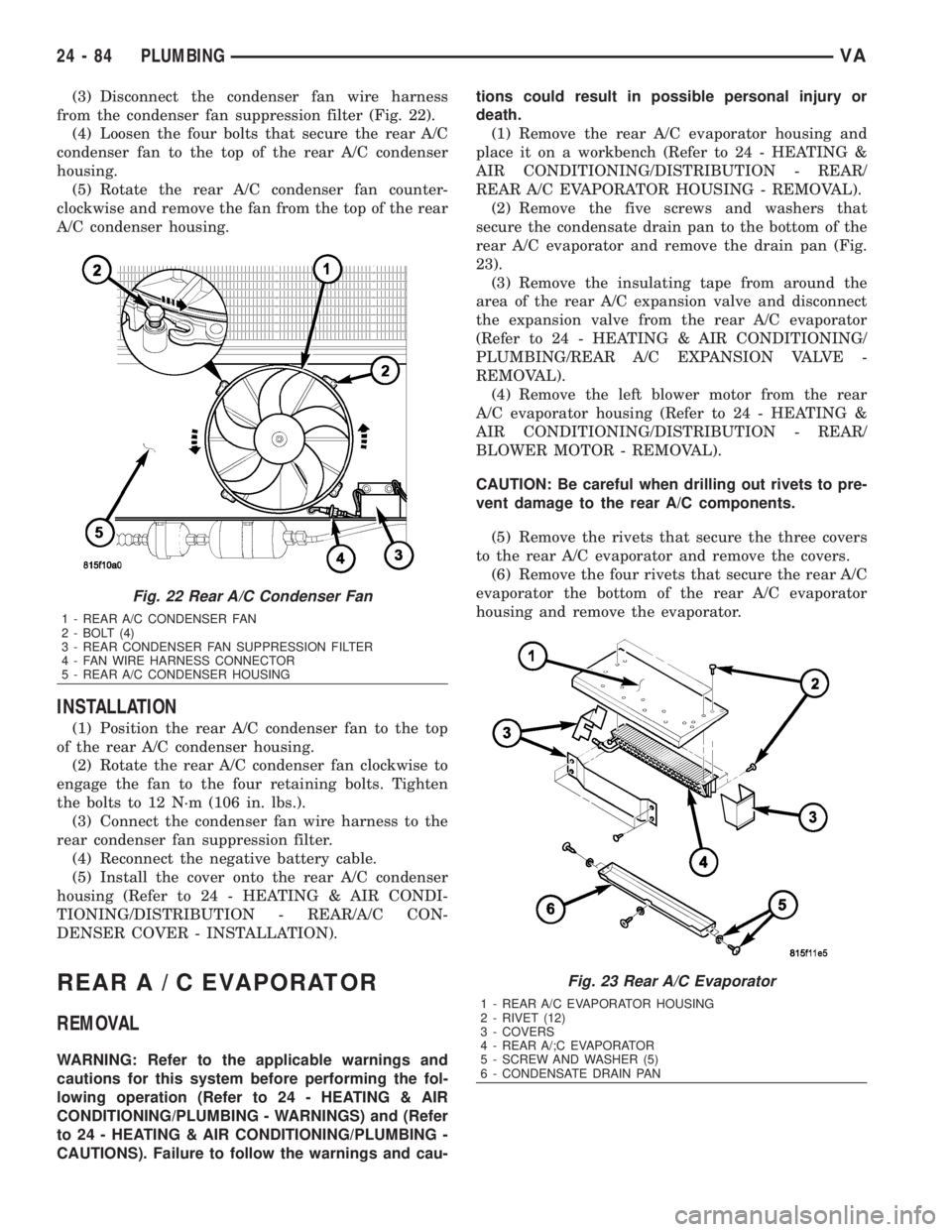
(3) Disconnect the condenser fan wire harness
from the condenser fan suppression filter (Fig. 22).
(4) Loosen the four bolts that secure the rear A/C
condenser fan to the top of the rear A/C condenser
housing.
(5) Rotate the rear A/C condenser fan counter-
clockwise and remove the fan from the top of the rear
A/C condenser housing.
INSTALLATION
(1) Position the rear A/C condenser fan to the top
of the rear A/C condenser housing.
(2) Rotate the rear A/C condenser fan clockwise to
engage the fan to the four retaining bolts. Tighten
the bolts to 12 N´m (106 in. lbs.).
(3) Connect the condenser fan wire harness to the
rear condenser fan suppression filter.
(4) Reconnect the negative battery cable.
(5) Install the cover onto the rear A/C condenser
housing (Refer to 24 - HEATING & AIR CONDI-
TIONING/DISTRIBUTION - REAR/A/C CON-
DENSER COVER - INSTALLATION).
REARA/CEVAPORATOR
REMOVAL
WARNING: Refer to the applicable warnings and
cautions for this system before performing the fol-
lowing operation (Refer to 24 - HEATING & AIR
CONDITIONING/PLUMBING - WARNINGS) and (Refer
to 24 - HEATING & AIR CONDITIONING/PLUMBING -
CAUTIONS). Failure to follow the warnings and cau-tions could result in possible personal injury or
death.
(1) Remove the rear A/C evaporator housing and
place it on a workbench (Refer to 24 - HEATING &
AIR CONDITIONING/DISTRIBUTION - REAR/
REAR A/C EVAPORATOR HOUSING - REMOVAL).
(2) Remove the five screws and washers that
secure the condensate drain pan to the bottom of the
rear A/C evaporator and remove the drain pan (Fig.
23).
(3) Remove the insulating tape from around the
area of the rear A/C expansion valve and disconnect
the expansion valve from the rear A/C evaporator
(Refer to 24 - HEATING & AIR CONDITIONING/
PLUMBING/REAR A/C EXPANSION VALVE -
REMOVAL).
(4) Remove the left blower motor from the rear
A/C evaporator housing (Refer to 24 - HEATING &
AIR CONDITIONING/DISTRIBUTION - REAR/
BLOWER MOTOR - REMOVAL).
CAUTION: Be careful when drilling out rivets to pre-
vent damage to the rear A/C components.
(5) Remove the rivets that secure the three covers
to the rear A/C evaporator and remove the covers.
(6) Remove the four rivets that secure the rear A/C
evaporator the bottom of the rear A/C evaporator
housing and remove the evaporator.
Fig. 22 Rear A/C Condenser Fan
1 - REAR A/C CONDENSER FAN
2 - BOLT (4)
3 - REAR CONDENSER FAN SUPPRESSION FILTER
4 - FAN WIRE HARNESS CONNECTOR
5 - REAR A/C CONDENSER HOUSING
Fig. 23 Rear A/C Evaporator
1 - REAR A/C EVAPORATOR HOUSING
2 - RIVET (12)
3 - COVERS
4 - REAR A/;C EVAPORATOR
5 - SCREW AND WASHER (5)
6 - CONDENSATE DRAIN PAN
24 - 84 PLUMBINGVA
Page 2122 of 2305
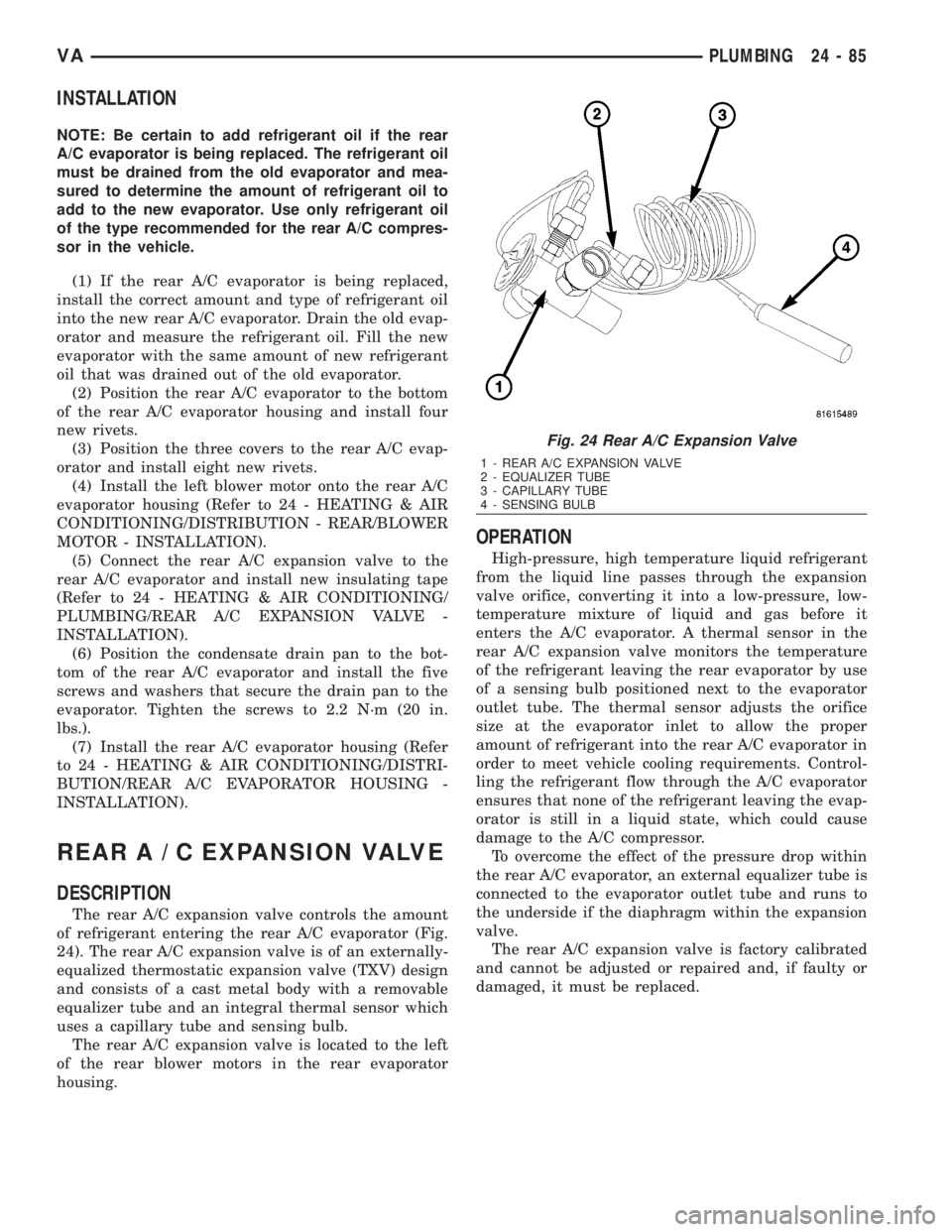
INSTALLATION
NOTE: Be certain to add refrigerant oil if the rear
A/C evaporator is being replaced. The refrigerant oil
must be drained from the old evaporator and mea-
sured to determine the amount of refrigerant oil to
add to the new evaporator. Use only refrigerant oil
of the type recommended for the rear A/C compres-
sor in the vehicle.
(1) If the rear A/C evaporator is being replaced,
install the correct amount and type of refrigerant oil
into the new rear A/C evaporator. Drain the old evap-
orator and measure the refrigerant oil. Fill the new
evaporator with the same amount of new refrigerant
oil that was drained out of the old evaporator.
(2) Position the rear A/C evaporator to the bottom
of the rear A/C evaporator housing and install four
new rivets.
(3) Position the three covers to the rear A/C evap-
orator and install eight new rivets.
(4) Install the left blower motor onto the rear A/C
evaporator housing (Refer to 24 - HEATING & AIR
CONDITIONING/DISTRIBUTION - REAR/BLOWER
MOTOR - INSTALLATION).
(5) Connect the rear A/C expansion valve to the
rear A/C evaporator and install new insulating tape
(Refer to 24 - HEATING & AIR CONDITIONING/
PLUMBING/REAR A/C EXPANSION VALVE -
INSTALLATION).
(6) Position the condensate drain pan to the bot-
tom of the rear A/C evaporator and install the five
screws and washers that secure the drain pan to the
evaporator. Tighten the screws to 2.2 N´m (20 in.
lbs.).
(7) Install the rear A/C evaporator housing (Refer
to 24 - HEATING & AIR CONDITIONING/DISTRI-
BUTION/REAR A/C EVAPORATOR HOUSING -
INSTALLATION).
REARA/CEXPANSION VALVE
DESCRIPTION
The rear A/C expansion valve controls the amount
of refrigerant entering the rear A/C evaporator (Fig.
24). The rear A/C expansion valve is of an externally-
equalized thermostatic expansion valve (TXV) design
and consists of a cast metal body with a removable
equalizer tube and an integral thermal sensor which
uses a capillary tube and sensing bulb.
The rear A/C expansion valve is located to the left
of the rear blower motors in the rear evaporator
housing.
OPERATION
High-pressure, high temperature liquid refrigerant
from the liquid line passes through the expansion
valve orifice, converting it into a low-pressure, low-
temperature mixture of liquid and gas before it
enters the A/C evaporator. A thermal sensor in the
rear A/C expansion valve monitors the temperature
of the refrigerant leaving the rear evaporator by use
of a sensing bulb positioned next to the evaporator
outlet tube. The thermal sensor adjusts the orifice
size at the evaporator inlet to allow the proper
amount of refrigerant into the rear A/C evaporator in
order to meet vehicle cooling requirements. Control-
ling the refrigerant flow through the A/C evaporator
ensures that none of the refrigerant leaving the evap-
orator is still in a liquid state, which could cause
damage to the A/C compressor.
To overcome the effect of the pressure drop within
the rear A/C evaporator, an external equalizer tube is
connected to the evaporator outlet tube and runs to
the underside if the diaphragm within the expansion
valve.
The rear A/C expansion valve is factory calibrated
and cannot be adjusted or repaired and, if faulty or
damaged, it must be replaced.
Fig. 24 Rear A/C Expansion Valve
1 - REAR A/C EXPANSION VALVE
2 - EQUALIZER TUBE
3 - CAPILLARY TUBE
4 - SENSING BULB
VAPLUMBING 24 - 85
Page 2123 of 2305
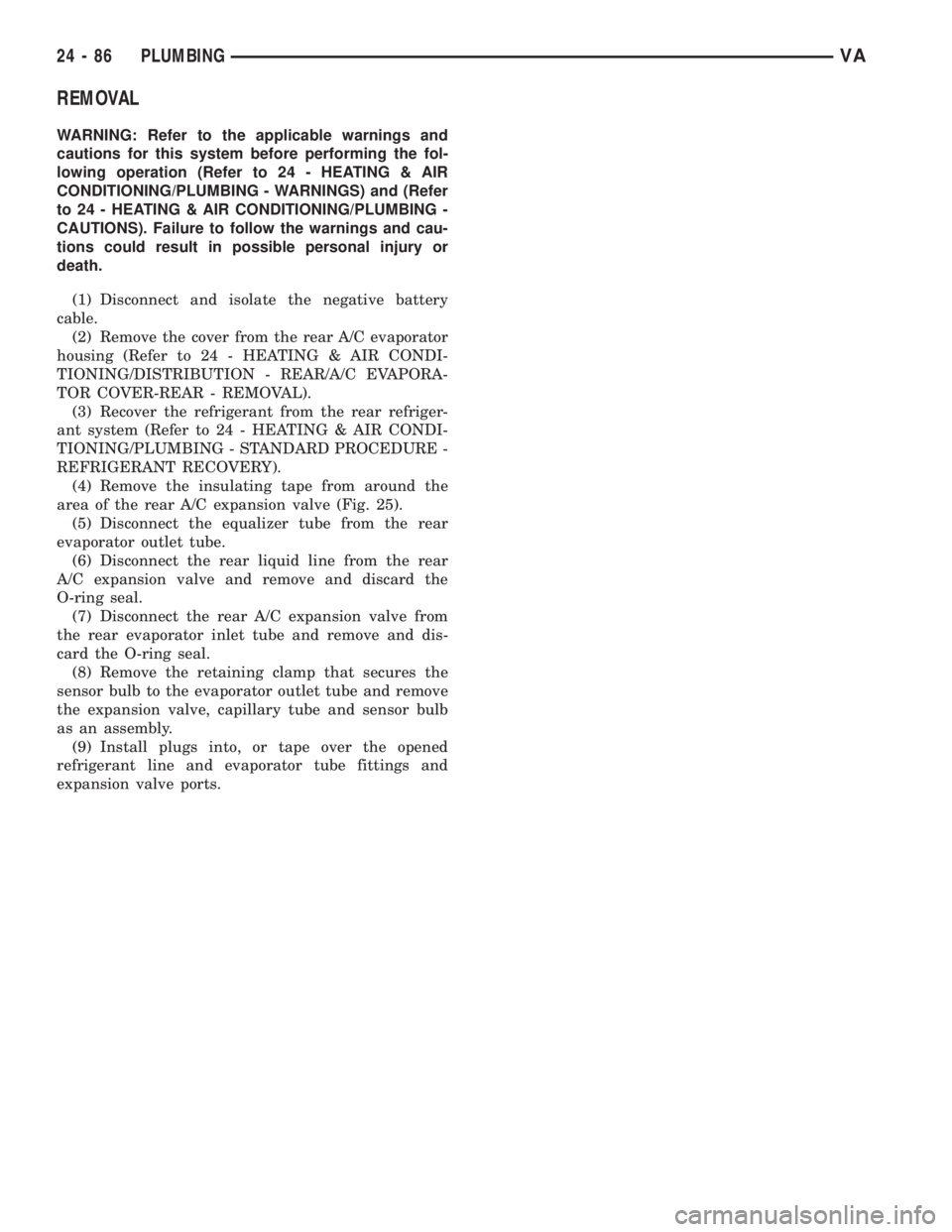
REMOVAL
WARNING: Refer to the applicable warnings and
cautions for this system before performing the fol-
lowing operation (Refer to 24 - HEATING & AIR
CONDITIONING/PLUMBING - WARNINGS) and (Refer
to 24 - HEATING & AIR CONDITIONING/PLUMBING -
CAUTIONS). Failure to follow the warnings and cau-
tions could result in possible personal injury or
death.
(1) Disconnect and isolate the negative battery
cable.
(2) Remove the cover from the rear A/C evaporator
housing (Refer to 24 - HEATING & AIR CONDI-
TIONING/DISTRIBUTION - REAR/A/C EVAPORA-
TOR COVER-REAR - REMOVAL).
(3) Recover the refrigerant from the rear refriger-
ant system (Refer to 24 - HEATING & AIR CONDI-
TIONING/PLUMBING - STANDARD PROCEDURE -
REFRIGERANT RECOVERY).
(4) Remove the insulating tape from around the
area of the rear A/C expansion valve (Fig. 25).
(5) Disconnect the equalizer tube from the rear
evaporator outlet tube.
(6) Disconnect the rear liquid line from the rear
A/C expansion valve and remove and discard the
O-ring seal.
(7) Disconnect the rear A/C expansion valve from
the rear evaporator inlet tube and remove and dis-
card the O-ring seal.
(8) Remove the retaining clamp that secures the
sensor bulb to the evaporator outlet tube and remove
the expansion valve, capillary tube and sensor bulb
as an assembly.
(9) Install plugs into, or tape over the opened
refrigerant line and evaporator tube fittings and
expansion valve ports.
24 - 86 PLUMBINGVA
Page 2124 of 2305
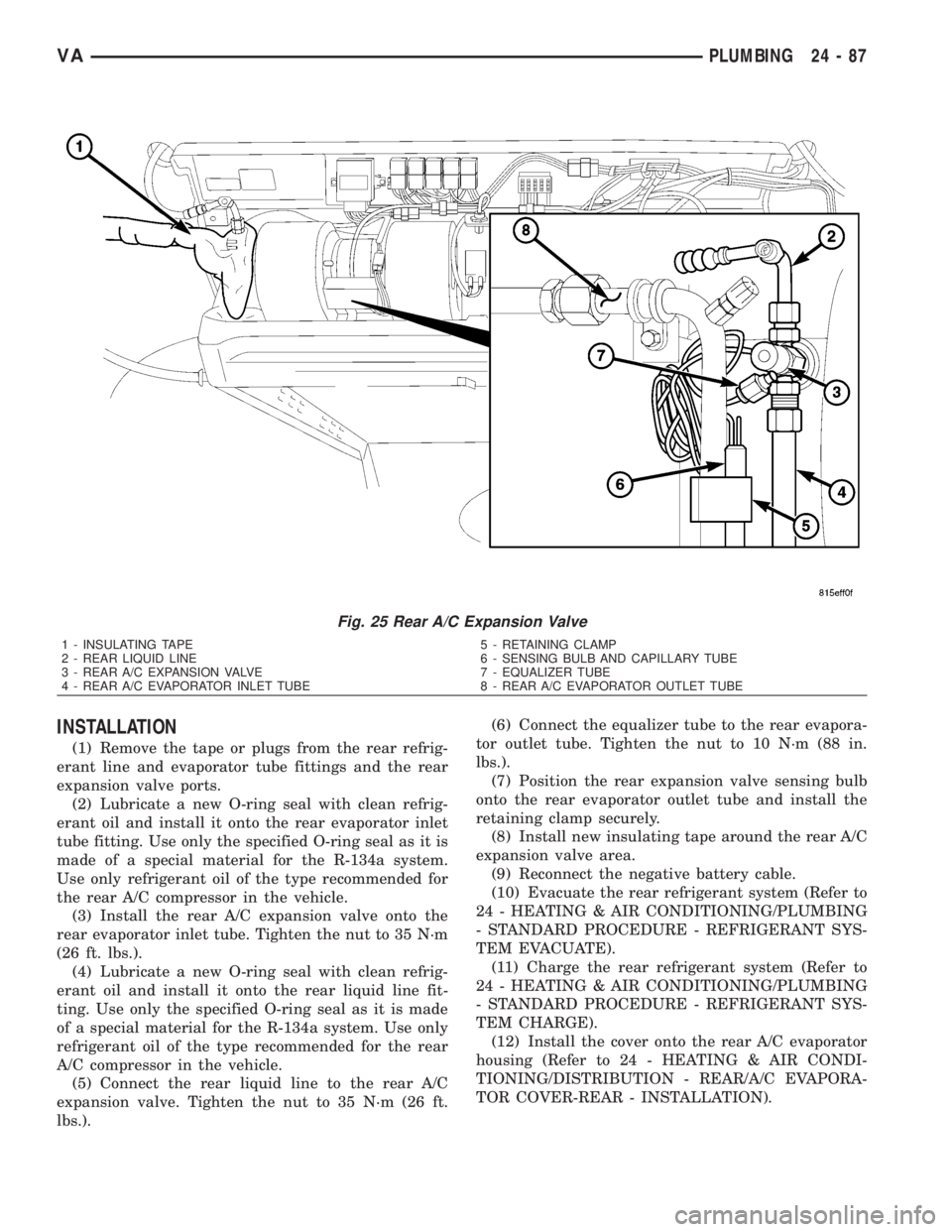
INSTALLATION
(1) Remove the tape or plugs from the rear refrig-
erant line and evaporator tube fittings and the rear
expansion valve ports.
(2) Lubricate a new O-ring seal with clean refrig-
erant oil and install it onto the rear evaporator inlet
tube fitting. Use only the specified O-ring seal as it is
made of a special material for the R-134a system.
Use only refrigerant oil of the type recommended for
the rear A/C compressor in the vehicle.
(3) Install the rear A/C expansion valve onto the
rear evaporator inlet tube. Tighten the nut to 35 N´m
(26 ft. lbs.).
(4) Lubricate a new O-ring seal with clean refrig-
erant oil and install it onto the rear liquid line fit-
ting. Use only the specified O-ring seal as it is made
of a special material for the R-134a system. Use only
refrigerant oil of the type recommended for the rear
A/C compressor in the vehicle.
(5) Connect the rear liquid line to the rear A/C
expansion valve. Tighten the nut to 35 N´m (26 ft.
lbs.).(6) Connect the equalizer tube to the rear evapora-
tor outlet tube. Tighten the nut to 10 N´m (88 in.
lbs.).
(7) Position the rear expansion valve sensing bulb
onto the rear evaporator outlet tube and install the
retaining clamp securely.
(8) Install new insulating tape around the rear A/C
expansion valve area.
(9) Reconnect the negative battery cable.
(10) Evacuate the rear refrigerant system (Refer to
24 - HEATING & AIR CONDITIONING/PLUMBING
- STANDARD PROCEDURE - REFRIGERANT SYS-
TEM EVACUATE).
(11) Charge the rear refrigerant system (Refer to
24 - HEATING & AIR CONDITIONING/PLUMBING
- STANDARD PROCEDURE - REFRIGERANT SYS-
TEM CHARGE).
(12) Install the cover onto the rear A/C evaporator
housing (Refer to 24 - HEATING & AIR CONDI-
TIONING/DISTRIBUTION - REAR/A/C EVAPORA-
TOR COVER-REAR - INSTALLATION).
Fig. 25 Rear A/C Expansion Valve
1 - INSULATING TAPE
2 - REAR LIQUID LINE
3 - REAR A/C EXPANSION VALVE
4 - REAR A/C EVAPORATOR INLET TUBE5 - RETAINING CLAMP
6 - SENSING BULB AND CAPILLARY TUBE
7 - EQUALIZER TUBE
8 - REAR A/C EVAPORATOR OUTLET TUBE
VAPLUMBING 24 - 87
Page 2125 of 2305
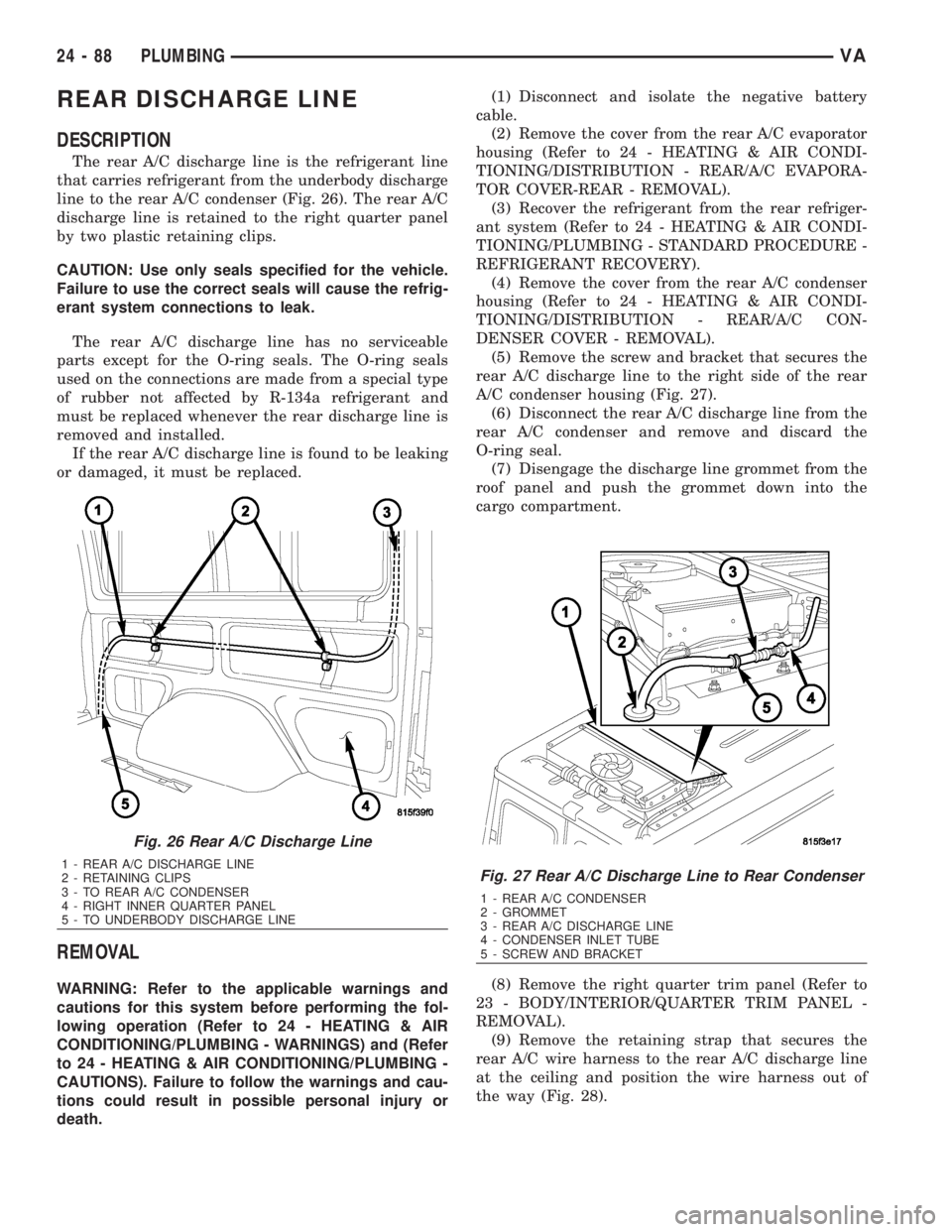
REAR DISCHARGE LINE
DESCRIPTION
The rear A/C discharge line is the refrigerant line
that carries refrigerant from the underbody discharge
line to the rear A/C condenser (Fig. 26). The rear A/C
discharge line is retained to the right quarter panel
by two plastic retaining clips.
CAUTION: Use only seals specified for the vehicle.
Failure to use the correct seals will cause the refrig-
erant system connections to leak.
The rear A/C discharge line has no serviceable
parts except for the O-ring seals. The O-ring seals
used on the connections are made from a special type
of rubber not affected by R-134a refrigerant and
must be replaced whenever the rear discharge line is
removed and installed.
If the rear A/C discharge line is found to be leaking
or damaged, it must be replaced.
REMOVAL
WARNING: Refer to the applicable warnings and
cautions for this system before performing the fol-
lowing operation (Refer to 24 - HEATING & AIR
CONDITIONING/PLUMBING - WARNINGS) and (Refer
to 24 - HEATING & AIR CONDITIONING/PLUMBING -
CAUTIONS). Failure to follow the warnings and cau-
tions could result in possible personal injury or
death.(1) Disconnect and isolate the negative battery
cable.
(2) Remove the cover from the rear A/C evaporator
housing (Refer to 24 - HEATING & AIR CONDI-
TIONING/DISTRIBUTION - REAR/A/C EVAPORA-
TOR COVER-REAR - REMOVAL).
(3) Recover the refrigerant from the rear refriger-
ant system (Refer to 24 - HEATING & AIR CONDI-
TIONING/PLUMBING - STANDARD PROCEDURE -
REFRIGERANT RECOVERY).
(4) Remove the cover from the rear A/C condenser
housing (Refer to 24 - HEATING & AIR CONDI-
TIONING/DISTRIBUTION - REAR/A/C CON-
DENSER COVER - REMOVAL).
(5) Remove the screw and bracket that secures the
rear A/C discharge line to the right side of the rear
A/C condenser housing (Fig. 27).
(6) Disconnect the rear A/C discharge line from the
rear A/C condenser and remove and discard the
O-ring seal.
(7) Disengage the discharge line grommet from the
roof panel and push the grommet down into the
cargo compartment.
(8) Remove the right quarter trim panel (Refer to
23 - BODY/INTERIOR/QUARTER TRIM PANEL -
REMOVAL).
(9) Remove the retaining strap that secures the
rear A/C wire harness to the rear A/C discharge line
at the ceiling and position the wire harness out of
the way (Fig. 28).
Fig. 26 Rear A/C Discharge Line
1 - REAR A/C DISCHARGE LINE
2 - RETAINING CLIPS
3 - TO REAR A/C CONDENSER
4 - RIGHT INNER QUARTER PANEL
5 - TO UNDERBODY DISCHARGE LINEFig. 27 Rear A/C Discharge Line to Rear Condenser
1 - REAR A/C CONDENSER
2 - GROMMET
3 - REAR A/C DISCHARGE LINE
4 - CONDENSER INLET TUBE
5 - SCREW AND BRACKET
24 - 88 PLUMBINGVA